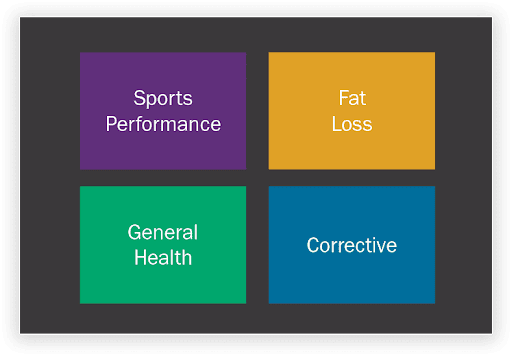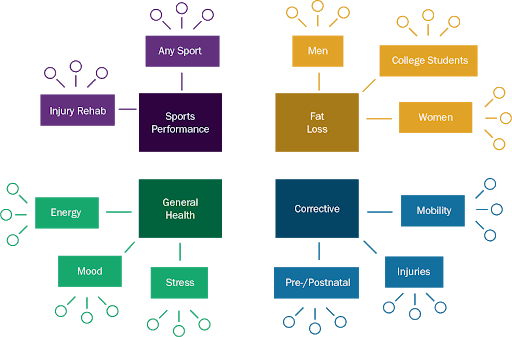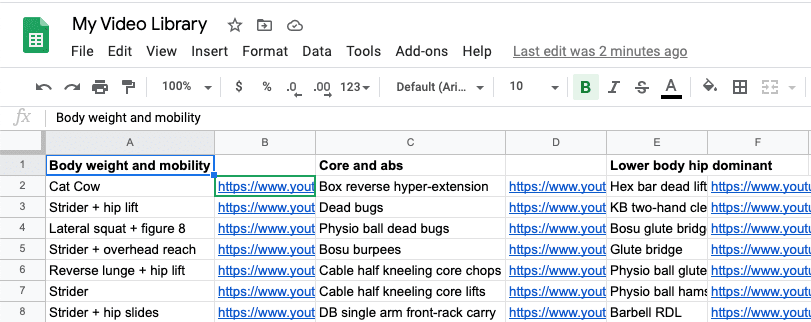Are you a fitness professional who loves to train clients, but feel like you’ve hit the iron ceiling in your career? If so, then the solution for you might be to become an online trainer.
You can get started by following these seven steps:
1. Decide what types of clients you want to work with online
2. Create a template with three or four training phases for each type of client
3. Compile a video library of the exercises in your online training programs
4. Register for professional software
5. Decide on the best package and online training pricing model for you
6. Create an online personal training questionnaire
7. Choose a payment processing service
But before I explain each of them, let me tell you how I got here.
When personal training forced me into online fitness
I trained clients in-person for eight years.
For most of it, I wasn’t happy. I was scared.
With my earning potential maxed, the long hours meant I had no time for friends, family, or a girlfriend.
The catalytic point for me happened during an ice hockey game one night. I got tripped and strained my hamstring.
For most people, a hamstring injury is an inconvenience. For a trainer, it’s a catastrophe.
You can’t train clients from your couch, which means you can’t make a living.
That was when it all changed for me.
I thought, “If a single injury could wipe out two weeks’ worth of income, training clients isn’t a secure way to make a living. Too many things can go wrong.”
Online personal training, on the other hand, is more than sustainable.
It’s efficient.
It allows you to systematize and scale your business, training more clients, in less time, while potentially making more money.
So let’s talk about how to get started as an online personal trainer.
—
Step 1: Decide what types of clients you want to work with online
All the time I hear trainers say,
“There’s so many online trainers, why would someone want to work with me?”
Easy. Because you’re not those other trainers.
You’re you.
That gives you an advantage over every other trainer out there—even “fitness influencers” and “InstaTrainers” with thousands of online followers.
The big secret to selling online training is to be the right person for a few people.
All it takes is 30 clients paying you $200 a month to make $72,000 a year.
You don’t need 10,000+ Instagram followers or a massive marketing budget.
What you need is to find your 1 Percent Uniqueness Factor—a niche where you have a clear advantage.
This is different from the same old “find your niche” advice you’ve seen before. It’s deeper, and much, much more powerful.
At the Online Trainer Academy, we teach a proven three-part system that can help any fitness or nutrition pro find their 1 Percent Uniqueness Factor. Normally, you’d have to enroll in OTA to learn about it. But I’ll share it with you here:
STEP 1: IDENTIFY YOUR PARENT MARKET
Everything we do in the fitness industry can be categorized into four markets. Start by picking the one you align with best.

STEP 2: GO DEEPER
Next you’ll pick your submarket. Some examples:

STEP 3: FIND YOUR 1% UNIQUENESS FACTOR
Time to brainstorm!
Each submarket has thousands of potential niches.
When deciding which is right for you, think about not just your professional skillset, but also your personal experiences, outside interests, and whatever else makes you you.

For example, here are some niches within the pre- and postnatal category:
- Young mothers
- Older mothers
- C-section
- Diastasis recti
- Mothers with multiple kids
- Military wives who are mothers
Or you could get a bit crazy and combine them:
- Young mothers who are military wives and have had C-sections.
Now that is unique!
Don’t worry about getting too narrow. Yes, you’ll be cutting off some potential clients. But those who fit your market will see you as the obvious choice.
Think about it this way: If you needed surgery for a hernia, would you prefer a general surgeon or a hernia specialist?
Which brings me to . . .
The secret to becoming a successful online personal trainer in two simple sentences:
“Try to attract everyone, and you’ll attract no one. Try to attract a few people, and everyone will see you as the expert.”
Once you find your niche, marketing becomes easy.
In this example, you’d network in military spouse groups. You’d produce content on how to get back to being active after a C-section. You’d start your own community for military moms.
Translation: More focus. Better results. Less effort.
No more endless (and directionless) content production.
No more wasting time and energy.
All your efforts moving forward will be laser-focused and produce results.
And the best part? Once you get your first handful of clients (which you will, fast), you simply have to do a great job training them. That’s when the referrals (both in and outside your niche) will roll in.
Remember what I said earlier: To make $72,000 this year, all you need is 30 clients paying you $200 a month.
What do you think is the best way to get and keep 30 paying clients? Will another 2,000 followers on Instagram make any difference?
—
Step 2: Create a template with three or four training phases for each type of client
You may think templated workouts are a disservice to your clients. But if you do them correctly, the opposite is true.
The reality is, most clients fit pretty well into categories.
In any setting, the workout you write for a 40-year-old man who wants to lose belly fat will be pretty similar to the last one you wrote for that type of client.
A template doesn’t mean you won’t individualize it. You’ll adapt it for each client based on your onboarding process and initial assessment.
And then you’ll continue to modify it over time as you see what does or doesn’t work for this client, and as you develop a deeper understanding of your client’s goals and abilities.
Some parts of the template won’t likely change from client to client:
· Programming considerations – Things like sets, reps, rest, and tempo will likely stay constant.
· Order of movement patterns – Your first exercise may not always be a squat or deadlift, but it’ll probably be some sort of multijoint lower-body movement.
· Workout split over the week – How many times the client trains and how the programs are split over the course of the week likely won’t change much.
Other parts of the template will probably change from client to client:
· Specific exercises – While the exercise category will stay the same, the specific exercise may change as you take into account the client’s experience, skill level, and previous injuries or limitations.
· Grips or implements – Clients will have access to different types of equipment, and, as noted, different abilities and restrictions.
· Specific aesthetic aspirations – Even among fat-loss clients, you’ll find a lot of variety in how they describe the type of physique they want to achieve. For some it might focus on waist size. For another it may be about a more athletic appearance, or wider shoulders, or bigger arms.
—
Step 3: Compile a video library of the exercises in your online training programs
Since you’re not there to demonstrate exercises for your clients, you need videos to show them how to do each movement.
If you don’t have your own—and most trainers don’t—you should compile a set of links to other trainers’ YouTube videos. It’s easy to find good examples of the form you recommend for the most well-known exercises.
If you use online personal training software (see Step 4), you’ll start out with a ready-made video library. But it’s unlikely that any platform will have videos of every exercise in your program, including all the progressions, regressions, and modifications you like to use. In those cases, you’ll still need to shoot and upload your own videos.
What makes a good exercise video?
Keep it simple, following these basic guidelines:
● No sound
● Decent lighting (don’t shoot in your basement, in other words)
● At least two full reps
● 10 to 20 seconds long
Remember, these aren’t tutorials. They’re demonstrations. They’re for instant reference in the middle of a workout. Chances are your client will be listening to her own music, and doesn’t want to shut it off to listen to you talk about the exercise. She just wants to see how to do it.
Here’s a good example of a video demonstration. Notice how simple it is:
The video above is from Online Trainer Academy graduate John Kempf. For a good example of how to compile your own video library, and how to organize it on YouTube, check out his entire collection here. (I’ve included a screenshot below as well.)

From there, you’ll want to organize your video collection in a spreadsheet for easy reference.
This could be any combination of videos from the internet, both yours and those from other people. There’s nothing wrong passing along a video from somebody else to your clients for reference as long as it shows the form you recommend and you don’t pretend it’s your own.
A simple spreadsheet organized by movement pattern works well. Here’s an example of how to set it up:
—
Step 4: Register for professional software
I’m a big believer in making money before spending it.
Because of that, I developed free online training software for you to use called QuickCoach.Fit
 Software helps you be professional even with your first few clients. But you should never pay for software before you’re making money.
Software helps you be professional even with your first few clients. But you should never pay for software before you’re making money.
QuickCoach is 100% free with unlimited clients and workouts. It’s a simple and professional solution tailor-made for coaches with 30 clients or fewer.
–> Click here to register for your free QuickCoach.Fit account
Step 5: Decide on the best package and online training pricing model for you
As with personal training software, there’s no “best” online training business model. Your goal is to find the right one for you, the one that plays to your strengths without exposing your weaknesses.
In this section I’ll share the four most common models, the pros and cons of each, and the most common price range for online training.
1-on-1 (one to a few)
One trainer works with five to 30 clients.
Price range
$100 to $500 a month.
Pros
- Realistic and stable.
- Doesn’t require a big change in service or marketing from in-person training.
- Doesn’t require advanced marketing, tech savvy, paid advertising, software, or a website.
Cons
- Slower to start.
- Lacks scalability.
Verdict:
The 1-on-1 model is where most online trainers should start but few will end up.
This is the model we teach in the Online Trainer Academy Level 1.
High-ticket transformation programs
One trainer works with a small to medium number of affluent clients, all of whom want to achieve a specific, measurable result (lower weight, smaller dress size, bigger arms or shoulders) in a defined time period.
Price range
$1,000 to $5,000 for eight to 12 weeks.
Pros
- Can be extremely profitable.
- Allows you to commit more of your time to each individual client.
- Marketing is more seamless when you sell a specific outcome vs. open-ended coaching.
Cons
- Long and complex sales and conversion process; most sales require content, paid ads, and at least two phone calls per client.
- Requires well-developed sales skills.
- Uncertain and potentially fragile income stream; losing a single client can rock your bottom line, and it can take a long time to replace them.
Verdict
A high-ticket transformation program works well for seasoned online trainers who’re willing to invest substantial time and resources into creating content, developing sales skills, and investing in paid advertising.
This is the model we teach in the Online Trainer Mentorship, which is only available to coaches who already make at least $1,000 a month online.
Hybrid online training
The hybrid model leverages technology to combine in-person training with online coaching.
Price range
$50 to $200 a month, plus whatever you charge for each in-person session.
Pros
- Can be a great transition from in-person to online coaching because you develop two stable revenue streams without depending on either for 100 percent of your income.
- Gives each client a more flexible and cost-effective training option.
Cons
- You’re still limited by location.
- Can be hard to get some of your in-person clients to buy into the idea; some just won’t see the benefits the new model offers.
Verdict
The hybrid model is great for gym-based trainers who don’t want to stop working with clients in person, or who want to switch to online coaching but need a way to maintain their income while making the transition.
We teach the hybrid online training model in the Online Trainer Academy Level 1.
Low-end membership (one to many)
One trainer works simultaneously with 50-plus clients who pay lower fees, usually through a membership platform.
Price
$10 to $50 a month.
Pros
- Extremely scalable (if you can make it work).
Cons
- It’s very difficult to differentiate yourself from the competition at low price points.
- Lots of customers mean lots of headaches.
- When factoring in lifetime customer value and customer acquisition costs, it’s extremely hard to make it work.
Verdict
The only case where I recommend this model is if the trainer has a platform with a huge organic following, generating thousands of free leads.
We don’t teach this model in any of our programs because we’ve only seen it work for a handful of outliers who already have massive audiences for their products or content.
—
Step 6: Create an online personal training application
No matter how you generate leads for your online training business (content, social media, referral, advertising), one thing is certain:
The only reason you generate traffic and market online is to attract a prospect and persuade them to enter their information into your system so you can follow up.
The better and more efficiently you do this, the more successful you’ll become.
It’s that simple.
An application form is really simple. Think of it as a virtual handshake. The goal is to gather info and build rapport.
It’s free to set up with Google forms.
Here’s what to include:
- The basics: Name, age, gender, email, phone number.
- Health information: Injury history, illnesses, or limitations.
- Training history: What have they done in the past?
- Rapport builders: Ask a question or two to build rapport (favorite movie, superhero, etc.).
- Script-flipping questions: Why does this person want to train with you specifically?
- Prequalifying questions: Ask a yes-or-no question to determine if they’re willing to invest money on their health and fitness. Make the questions specific to the price range of your services ($200 to $400 a month, for example).
Think of the application form as your first meeting with a client, as I explain in this five-minute video from the Online Trainer Academy:
One good example from an OTA graduate:
· Here’s a longer, more personality-driven Google form (it asks if you’re willing to “eat blended chicken and unicorn blood” to achieve your goals) from Tyler DiRienzo.
—
Step 7: Choose an online training payment processing service
This step is simple.
Use PayPal if you’re comfortable with it.
It’s easy to implement, fees are reasonable, and you can deposit money directly into your bank account for free.
If you’re in the United States, Venmo is an option with lower fees. Just keep in mind that you can’t use it internationally.
On the subject of credit card processing fees:
It’s a cost of doing business. Worried about the 3 percent fee? Charge 5 percent more.
